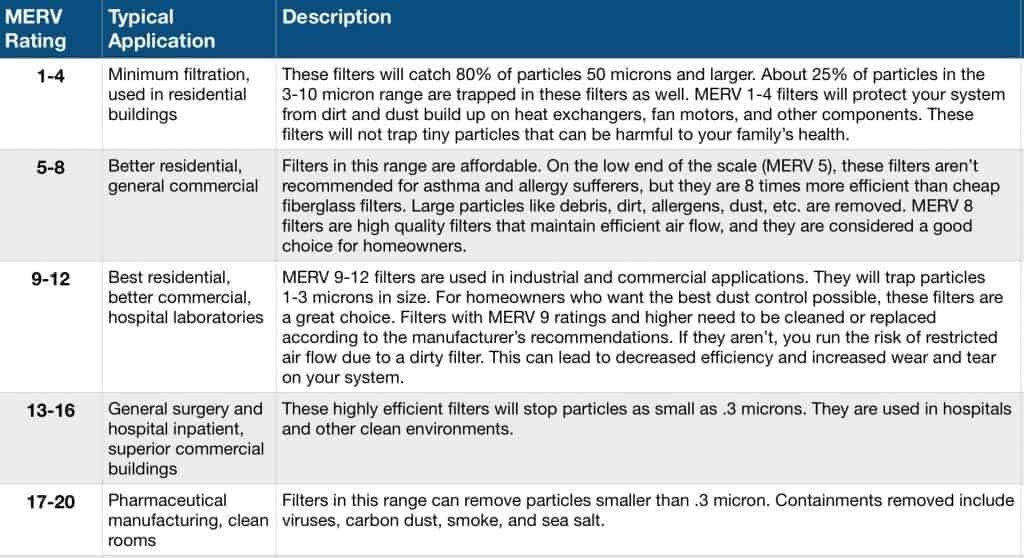What is MERV?
We’ve been hearing a lot about MERV. Who is this MERV guy, anyway? MERV Griffin, maybe? If you’re confused about MERV ratings, rest assured, you are not the only one. If you’re a home owner, it’s important to know what MERV ratings are and what they actually mean for you and your family.
MERV is the Minimum Efficiency Reporting Value, which is a scale designedly ASHRAE (American Society of Heating, Refrigerating and Air-Conditioning Engineers) to rate the effectiveness of air filters. MERV ratings range from 1-20. The higher the MERV rating, the fewer contaminants and dust particles can pass through the filter. ASHRAE set up this rating system to evaluate a filter’s performance at removing particles .3 to 10 microns.
Common particles removed by filters are dust mites, pollen, mold spores, pet dander, dust, tobacco smoke, and bacteria. The most recommended MERV ratings for residential systems are MERV 7-13.
Higher Doesn’t Always Mean Better
You would assume that a higher MERV rating would translate to a better filter for your home, but that’s not necessarily the case. The higher rating, the smaller the pores are for air to flow through your filter. Your system may not be designed to manage this level of restricted air flow. This restriction can lead to poor air quality and put unwanted stress on your HVAC system.
Our suggestion: Find out the highest MERV rating filter that’s best for your home. If you have trouble finding the answer, don’t hesitate to contact us, or ask one of our HVAC specialists during your next Spring Tune-Up or Fall Check-Up.
MERV 1-4
Typical Application: Minimum filtration, used in residential buildings
These filters will catch 80% of particles 50 microns and larger. About 25% of particles in the 3-10 micron range are trapped in these filters as well. MERV 1-4 filters will protect your system from dirt and dust build up on heat exchangers, fan motors, and other components. These filters will not trap tiny particles that can be harmful to your family’s health.
MERV 5-8
Typical Application: Better residential, general commercial
Filters in this range are affordable. On the low end of the scale (MERV 5), these filters aren’t recommended for asthma and allergy sufferers, but they are 8 times more efficient than cheap fiberglass filters. Large particles like debris, dirt, allergens, dust, etc. are removed. MERV 8 filters are high quality filters that maintain efficient air flow, and they are considered a good choice for homeowners.
MERV 9-12
Typical Application: Best residential, better commercial, hospital laboratories
MERV 9-12 filters are used in industrial and commercial applications. They will trap particles 1-3 microns in size. For homeowners who want the best dust control possible, these filters are a great choice. Filters with MERV 9 ratings and higher need to be cleaned or replaced according to the manufacturer’s recommendations. If they aren’t, you run the risk of restricted air flow due to a dirty filter. This can lead to decreased efficiency and increased wear and tear on your system.
MERV 13-16
Typical Application: General surgery and hospital inpatient, superior commercial buildings
These highly efficient filters will stop particles as small as .3 microns. They are used in hospitals and other clean environments.
MERV 17-20
Typical Application: Pharmaceutical manufacturing, clean rooms
Filters in this range can remove particles smaller than .3 micron. Containments removed include viruses, carbon dust, smoke, and sea salt.
